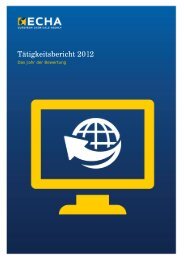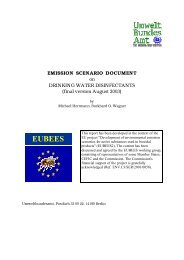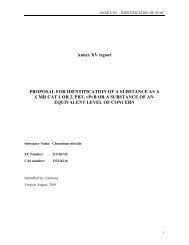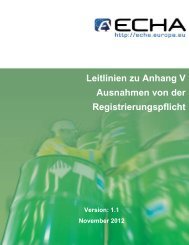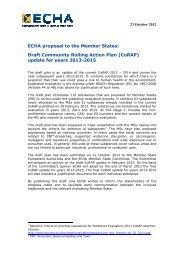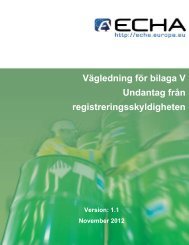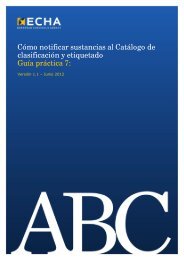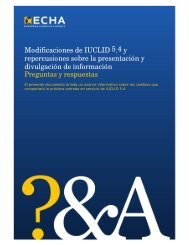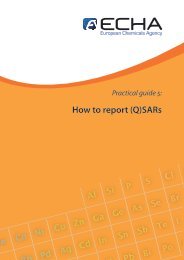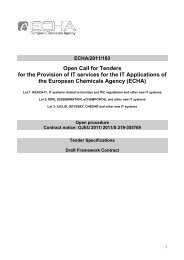Strategy For Limiting Risks Human Health Draft of ... - ECHA - Europa
Strategy For Limiting Risks Human Health Draft of ... - ECHA - Europa
Strategy For Limiting Risks Human Health Draft of ... - ECHA - Europa
You also want an ePaper? Increase the reach of your titles
YUMPU automatically turns print PDFs into web optimized ePapers that Google loves.
This reaction is separate from the reduction reaction <strong>of</strong> alumina to aluminium in Hall-Héroult<br />
process, which is the only smelting process used today industrially. Based on the molar<br />
masses <strong>of</strong> Na2O and cryolite, approximately 2 times the mass <strong>of</strong> Na2O <strong>of</strong> excess cryolite<br />
results, if no other sources <strong>of</strong> sodium are available and if losses <strong>of</strong> cryolite are excluded. In<br />
this case, one tonne <strong>of</strong> alumina fed to the process would produce normally ca. 4-10 kg excess<br />
cryolite. According to EAA (2007a), two tonnes <strong>of</strong> alumina is reduced to one tonne <strong>of</strong><br />
aluminium. Hence, one tonne <strong>of</strong> primary aluminium is based on the assumptions above<br />
accompanied by ca. 8-20 kg (0.8-2 % w/w) <strong>of</strong> excess cryolite as by-product.<br />
In modern smelters excess bath material is tapped from time to time. Concentrations <strong>of</strong> bath<br />
components vary within and between the sites depending on the alumina quality, other<br />
substances are added to the bath and on other process parameters. An example <strong>of</strong> the contents<br />
<strong>of</strong> bath material has been provided by Alcoa (Solvay, 2007):<br />
Cryolite 51-53 %<br />
Al2O3 45 % (WS: insoluble or < 1 mg/l according to IUCLID<br />
AlF3 7 % (WS: 5.3-9.4 at pH 5.9, European Commission, 2008)<br />
CaF2 3 %<br />
MgF2 1.2 %<br />
Carbon 0.8 %<br />
Fe2O3 0.27 %<br />
SiO2 0.25 %<br />
Moisture 0.25 % (Rapporteur assumes H2O is meant by this)<br />
It is noted, that the Rapporteur considers that bath material has another identity than cryolite.<br />
Already based on the very low water solubility <strong>of</strong> the substantial constituent Al2O3, properties<br />
<strong>of</strong> cryolite do not resemble the properties <strong>of</strong> bath material.<br />
Production capacity and tonnage<br />
Intended production<br />
Cryolite is produced at four sites in the EU-15. All sites provided information on exposure.<br />
Sites 2, 3 and 4 updated their information in 2006. Production volume <strong>of</strong> these four sites is<br />
23,561 t/a <strong>of</strong> which 11,500 t/a is exported. The volume for the European market is thus<br />
12,061 t/a. Production capacity was provided by three companies and it makes 43,200 t/a.<br />
Table 1.1: Production sites <strong>of</strong> synthetic cryolite in the EU-15<br />
Company Location<br />
Derivados del Fluor S.A. Spain, Onton<br />
Fluorsid S.p.A. Italy, Assemini (Cagliari)<br />
I.C.I.B. S.p.A. Italy, Treviglio (BG)<br />
Solvay Fluor und Derivate Germany, Bad Wimpfen<br />
8



